
Tree roots are always searching for moisture. A sewer line gives off a constant source of warm, nutrient-rich humidity, which makes it one of the most attractive targets in a yard. Most homeowners are surprised to learn that roots don’t break into a sewer line on their own. They follow clear signals in the soil that lead them straight to the pipe.
Roots Are Designed to Seek Out Moisture
As a tree grows, its roots reach out in every direction. They naturally move toward damp soil because that moisture carries nutrients the tree depends on. A sewer line releases small amounts of vapour through tiny joints, fittings or aging pipe material. Even those small traces of humidity are enough to guide roots toward the pipe.
Small Openings Become an Invitation
If a sewer line has any small gap or weakness, roots take advantage of it. Clay tiles, older cast iron and aging PVC connections are common spots where openings appear over time. Once a root tip reaches one of these points, it slips inside and begins to grow. The inside of the pipe is warm and wet, which creates the perfect environment for roots to expand quickly.
Growth Inside the Pipe Happens Fast
A root inside a sewer line grows much faster than it does in regular soil. It absorbs water directly from the flow inside the pipe. As it spreads, it forms a dense web that slows draining and eventually causes a full blockage. Many homeowners only notice the problem when sinks gurgle, toilets drain slowly or wastewater backs up into the basement.
Why Certain Properties Are More Prone
Some yards encourage root intrusion more than others. Large, mature trees have aggressive root systems. Homes with older clay or cast iron sewer lines are more vulnerable because joints loosen over time. Soil conditions also play a role. Loose, sandy soil lets roots travel greater distances in search of moisture.
How Homeowners Can Reduce the Risk
Regular sewer camera inspections can catch early signs of root intrusion before a blockage forms. Keeping large trees away from the sewer path helps as well. If a home has an older sewer line, replacement or trenchless rehabilitation creates a tight, sealed pipe that roots cannot reach. Routine maintenance keeps everything flowing smoothly and prevents roots from gaining a foothold.
Ready to Protect Your Sewer Line?
If you’ve noticed slow drains, gurgling fixtures or recurring blockages, it may be time to take a closer look at what’s happening underground. Book a sewer camera inspection and let our team confirm what’s going on inside your line. Early detection saves homeowners from major repairs and unexpected plumbing emergencies.